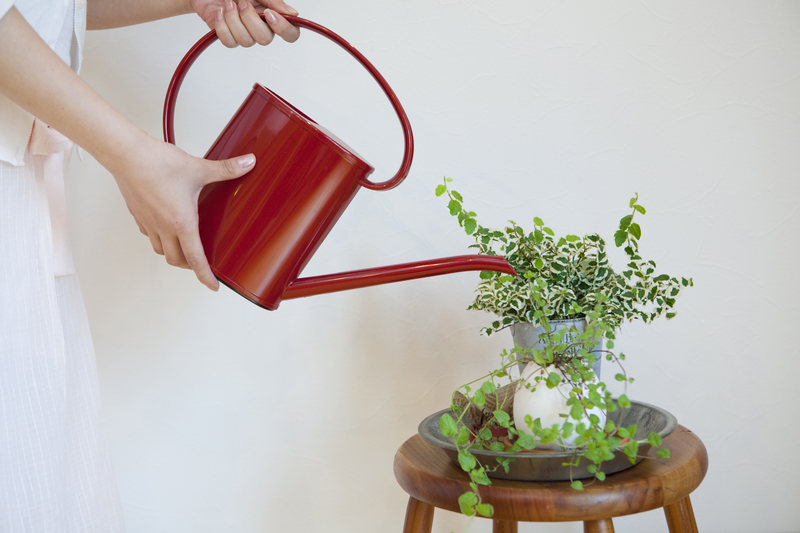Aesthetic Principles for Creating Great Garden Seating
Posted on 29/08/2025
Aesthetic Principles for Creating Great Garden Seating
Transforming your outdoor space into a peaceful and visually captivating retreat starts with thoughtful garden seating design. Well-planned seating not only boosts your garden's comfort and functionality but also adds structure, style, and personality to your landscape. In this comprehensive guide, we'll explore the essential aesthetic principles for creating great garden seating, helping you achieve a seamless blend of beauty, harmony, and usability in your outdoor haven.

Understanding the Importance of Garden Seating
Seating in the garden invites people to linger, relax, and savor nature's beauty. Whether it's a cozy bench tucked under leafy trees or a set of chairs along a sun-dappled patio, the right outdoor seating creates focal points and encourages social interactions. However, comfort alone isn't enough--beautifully designed seating should merge aesthetics with practicality, complementing both the garden and your lifestyle.
Key Aesthetic Principles for Great Outdoor Seating
Applying fundamental design principles for garden seating elevates the look and feel of any garden. Let's explore the core elements that lead to spectacular results:
1. Harmony with the Surroundings
- Blending with Nature: Garden seating should complement the landscape, not compete with it. Choose materials, shapes, and colors that echo the plants, stones, or architectural elements of your garden.
- Consistent Style: Match the style of your seating--whether modern, rustic, or classic--with the overall design aesthetic of your garden for a cohesive look.
2. Proportion and Scale
- Right Size for the Space: Avoid oversized furniture that dominates small areas or tiny benches that get lost in large expanses.
- Balance: Create balance by matching the seating's visual weight with other garden structures or plantings.
3. Placement for Purpose and Views
- Strategic Positioning: Position garden seating where users can enjoy prime views of plant beds, water features, or the sunset.
- Functional Flow: Place seats where they fit naturally into garden pathways or outdoor "rooms" to invite easy access and movement.
- Sunlight & Shade: Consider the sun's path. Place some seats in full sun for cool days and others in shade for hot afternoons.
Material Selection: The Foundation of Aesthetic and Practical Excellence
The material you choose for your garden seating will greatly influence both its appearance and its durability. It's essential to pick materials that reflect the garden's overall theme while withstanding the elements.
Popular Materials for Garden Seating
- Wood: Wood brings a warm, natural feel and can be shaped into classic benches or contemporary loungers. Hardwoods like teak and cedar are naturally weather-resistant.
- Metal: Wrought iron and powder-coated steel offer elegance, intricate detailing, and durability. However, they can heat up or cool down quickly, so consider cushions for comfort.
- Stone: Stone benches blend effortlessly with landscapes, appearing as extensions of natural rock formations. They are solid and long-lasting--ideal for a formal or woodland setting.
- Recycled Materials: Eco-friendly options like recycled plastic mimic wood but require less maintenance.
When choosing a material, always consider maintenance, longevity, and harmony with the garden's overall color and texture palette.
Color Theory: Painting the Perfect Picture
Using color expertly can turn your garden bench or chairs into standout features or discreet complements. Here's how to approach color selection for garden seating:
- Subtle Hues: Earthy colors--such as brown, green, or grey--integrate seamlessly with plantings, creating a tranquil effect.
- Bolder Accents: Bright blues, reds, or yellows transform seats into playful accents or focal points, especially in gardens with lush, green backdrops.
- Monochrome Schemes: Single-color choices (e.g., all white or all black) achieve a chic, modern look, especially when echoed in planters or fencing.
Contrast and Coordination
- Coordinate seating colors with surrounding flowers and foliage for harmony.
- Use contrast strategically--such as a white bench among dark greenery or a deep teal chair beside golden grasses--to draw the eye and create visual interest.
Shape and Silhouette: Expressing Personality
Garden seating comes in all shapes and styles, from traditional benches to organic sculptural forms. The design you choose says a lot about your taste and the mood you want to set.
- Curved Benches: Invite intimacy and conversation, perfect for social areas or around a fire pit.
- Angular Forms: Convey modern sophistication and work well in contemporary gardens.
- Sculptural Pieces: Double as art, bringing a unique focal point to minimalist landscapes.
Selecting the right silhouette helps reinforce your overall outdoor seating design aesthetic.
Integrating Seating into the Landscape
Great garden seating doesn't just sit on top of the landscape--it becomes an integral part of it. Here's how to weave seating into your outdoor environment:
1. Nestling into Plantings
- Place benches or chairs partially surrounded by shrubs, ornamental grasses, or flowering perennials, making the seat feel sheltered and inviting.
- Use climbing plants--such as wisteria or roses--with arbors or pergolas above seating areas for shade and fragrance.
2. Creating Focal Points
- Position seating in a way that it frames a view, sculpture, or water feature--turning the seat into both a destination and a visual highlight.
3. Using Hardscape Elements
- Build benches into retaining walls or alongside raised beds for seamless integration and space savings.
- Floor materials--like paving stones or decking--can be extended beneath seating to define "rooms" for conversation or dining.
Comfort and Usability: Essential for Lasting Enjoyment
While aesthetics are key, a great garden seat must also be comfortable and practical. To ensure lasting enjoyment:
- Ergonomics: Opt for seats with supportive backs and armrests. Swings, hammocks, and lounge chairs add variety and comfort.
- Weather Protection: Provide options for shade, like umbrellas or pergolas, and ensure drainage so water won't pool on seats.
- Accessibility: Make sure there are level pathways and that the seating height suits users of all ages and abilities.
- Flexible Arrangements: Movable chairs and modular benches allow you to adapt the layout for different group sizes or events.
Enhancing Mood with Accessories
Details matter in creating aesthetic outdoor seating that feels inviting:
- Plush Cushions: Add softness and a splash of color. Use weather-resistant fabrics for fewer worries in the rain.
- Throws and Blankets: Encourage use in cooler evenings.
- Ambient Lighting: String lights, lanterns, or solar lamps make evening seating magical and safe.
- Side Tables: Provide a spot for refreshments or a good book.
- Potted Plants: Use containers to bring bursts of seasonal color or scent close to your seating areas.
Seasonal Flexibility and Adaptation
The best garden seating arrangements adapt as the seasons change:
- Shade in Summer: Retractable canopies or movable umbrellas let you control sun exposure.
- Wind Shelter: Hedges or walls protect against breezes in exposed sites.
- Moveable Furniture: Light, stackable seats can be shifted to take advantage of sun or shelter across the year.
Sustainable and Eco-Friendly Approaches
Sustainability isn't just a trend--it's a core principle for responsible garden design. Maximizing the eco-friendliness of your garden seating design can be both stylish and ethical:
- Use Reclaimed Materials: Upcycling old wood, bricks, or metal pipes gives new life to forgotten resources while adding character.
- Choose Certified Woods: Seek FSC-certified timber to ensure responsible forestry practices.
- Design for Durability: Select long-lasting materials and finishes that require minimal maintenance or replacement.
The Role of Personal Expression
Your garden is a reflection of your life and taste--let your seating express your personality:
- Customization: Personalize with painted patterns, carved inscriptions, or custom cushions.
- Art and Sculpture: Integrate artistic elements or unusual shapes for a unique signature look.
- Mix and Match: Combine vintage and modern seats or experiment with different colors for a playful, eclectic feel.
Common Mistakes to Avoid in Garden Seating Design
- Ineffective Placement: Seats in full sun with no shade or seating that faces away from the best views can go unused.
- Poor Materials Choice: Indoor furniture rarely stands up to the outdoor elements--ensure you select weatherproof pieces.
- Overcrowding: Too many seats can make the area cluttered and impede movement.
- Ignoring Maintenance: Choose easy-to-clean surfaces, especially if birds, sap, or leaves are common in your garden.
Inspiring Examples of Beautiful Garden Seating
- The Classic Wooden Bench nestled beneath a rose arch--timeless, fragrant, and ideal for contemplation.
- Modern Concrete and Timber Loungers set beside a sleek pond, reflecting minimalist aesthetics.
- Curved Stone Wall Seats built into tiered beds, with lavender and grasses brushing against the seat.
- Colorful Adirondack Chairs scattered across a wildflower meadow, bringing bursts of joy to the landscape.

Bringing It All Together: A Checklist for Aesthetic Garden Seating
- Observe the space: Note sun, shade, and views before picking seating locations.
- Select the right style: Match garden seating to your overall landscape theme.
- Pick durable, beautiful materials: Invest in both looks and longevity.
- Think about comfort: Use ergonomic designs and add soft furnishings.
- Integrate with the landscape: Nestle seats into plantings and hardscapes for a natural feel.
- Add interest with color and accessories: Cushions, throws, and lighting complete the experience.
- Embrace sustainability: Reuse materials and choose eco-friendly options where possible.
Conclusion: Craft Your Perfect Outdoor Retreat
Great garden seating is about more than just a place to rest--it's an opportunity to enhance your outdoor living space with thoughtful design, comfort, and style. By following aesthetic principles for creating great garden seating, you'll craft inviting, harmonious spots where memories are made, and the beauty of your garden is celebrated through every season. Whether you opt for classic benches, creative contemporary designs, or personalized touches, your outdoor seating should reflect who you are and invite both relaxation and connection with nature. Start designing today and turn your garden into your sanctuary.

